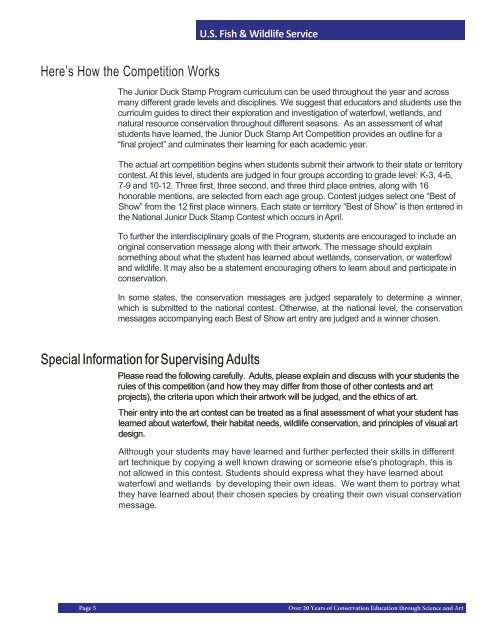Duck Stamp Conservation and Design Program and Art Contest
MFoI7p
MFoI7p
Create successful ePaper yourself
Turn your PDF publications into a flip-book with our unique Google optimized e-Paper software.
Here’s How the Competition Works<br />
U.S. Fish & Wildlife Service<br />
U.S. Fish Wildlife Service<br />
The Junior <strong>Duck</strong> <strong>Stamp</strong> <strong>Program</strong> curriculum can be used throughout the year <strong>and</strong> across<br />
many different grade levels <strong>and</strong> disciplines. We suggest that educators <strong>and</strong> students use the<br />
curriculm guides to direct their exploration <strong>and</strong> investigation of waterfowl, wetl<strong>and</strong>s, <strong>and</strong><br />
natural resource conservation throughout different seasons. As an assessment of what<br />
students have learned, the Junior <strong>Duck</strong> <strong>Stamp</strong> <strong>Art</strong> Competition provides an outline for a<br />
“final project” <strong>and</strong> culminates their learning for each academic year.<br />
The actual art competition begins when students submit their artwork to their state or territory<br />
contest. At this level, students are judged in four groups according to grade level: K-3, 4-6,<br />
7-9 <strong>and</strong> 10-12. Three first, three second, <strong>and</strong> three third place entries, along with 16<br />
honorable mentions, are selected from each age group. <strong>Contest</strong> judges select one “Best of<br />
Show” from the 12 first place winners. Each state or territory “Best of Show” is then entered in<br />
the National Junior <strong>Duck</strong> <strong>Stamp</strong> <strong>Contest</strong> which occurs in April.<br />
To further the interdisciplinary goals of the <strong>Program</strong>, students are encouraged to include an<br />
original conservation message along with their artwork. The message should explain<br />
something about what the student has learned about wetl<strong>and</strong>s, conservation, or waterfowl<br />
<strong>and</strong> wildlife. It may also be a statement encouraging others to learn about <strong>and</strong> participate in<br />
conservation.<br />
In some states, the conservation messages are judged separately to determine a winner,<br />
which is submitted to the national contest. Otherwise, at the national level, the conservation<br />
messages accompanying each Best of Show art entry are judged <strong>and</strong> a winner chosen.<br />
Special Information for Supervising Adults<br />
Please read the following carefully. Adults, please explain <strong>and</strong> discuss with your students the<br />
rules of this competition (<strong>and</strong> how they may differ from those of other contests <strong>and</strong> art<br />
projects), the criteria upon which their artwork will be judged, <strong>and</strong> the ethics of art.<br />
Their entry into the art contest can be treated as a final assessment of what your student has<br />
learned about waterfowl, their habitat needs, wildlife conservation, <strong>and</strong> principles of visual art<br />
design.<br />
Although your students may have learned <strong>and</strong> further perfected their skills in different<br />
art technique by copying a well known drawing or someone else's photograph, this is<br />
not allowed in this contest. Students should express what they have learned about<br />
waterfowl <strong>and</strong> wetl<strong>and</strong>s by developing their own ideas. We want them to portray what<br />
they have learned about their chosen species by creating their own visual conservation<br />
message.<br />
Page 5<br />
Over 20 Years of <strong>Conservation</strong> Education through Science <strong>and</strong> <strong>Art</strong>


